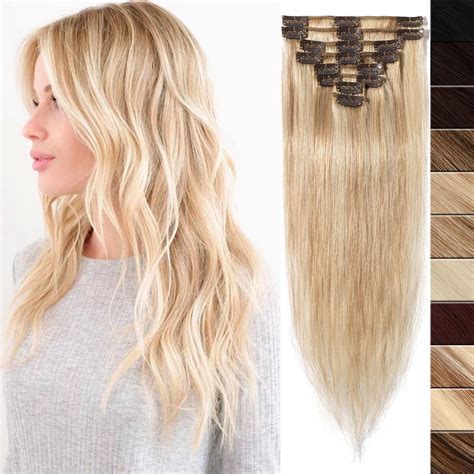Are you looking to achieve voluminous, luscious locks without the commitment of permanent extensions? Real hair clip-in extensions offer the perfect solution, transforming your hair in minutes. This comprehensive guide will provide an in-depth look at clip-in extensions, from their benefits to installation and maintenance.

Benefits of Real Hair Clip-In Extensions
- Instant volume and length: Clip-ins add instant fullness and length to your natural hair.
- Reversible: Easily removed at night or when desired, allowing you to switch up your look without damaging your hair.
- Versatile: Can be styled with heat tools, colored, and treated like your own hair.
- Natural appearance: Made from 100% human hair, clip-ins blend seamlessly into your natural locks.
- Damage-free: Unlike permanent extensions, clip-ins do not require adhesives or bonding agents, minimizing hair damage.
Choosing the Right Clip-In Extensions
- Length: Match the extension length to your desired hair length for a natural look.
- Color: Choose a color that complements your natural hair shade, or opt for a contrasting color for a bolder statement.
- Texture: Select extensions that match the texture of your own hair, whether it’s straight, wavy, or curly.
- Amount of Pieces: Determine the number of clip-ins needed based on your hair volume and desired fullness.
How to Install Real Hair Clip-In Extensions
Step 1: Prepare Your Hair
* Brush your hair to remove tangles.
* Section off the top layer of hair.
Step 2: Position the Clip-Ins
* Open a clip-in extension and place it against your natural hair at the root.
* Snap the clip into place, ensuring it is firmly attached.
Step 3: Repeat Process
* Continue adding clip-ins in horizontal sections, working from the back to the front.
* Use larger clips for the lower sections and smaller clips for the top.
Step 4: Blend the Extensions
* Gently brush or comb your hair to blend the extensions with your natural hair.
* Use a blow dryer to set the style and eliminate any visible lines.
Maintaining Real Hair Clip-In Extensions
- Wash and condition your extensions regularly with sulfate-free products.
- Use a wide-toothed comb or detangling brush to avoid tangles.
- Store your extensions in a breathable bag when not in use.
- Avoid excessive heat styling and prolonged exposure to chlorine or saltwater.
Creative Applications for Real Hair Clip-In Extensions
- Ponytail Enhancer: Add extra volume and length to your ponytail by clipping in extensions at the base.
- Bangs: Create temporary bangs by using a single clip-in extension as a fringe.
- Headband: Use a row of clip-ins as a stylish headband, covering up roots or adding a pop of color.
- Double Buns: Elevate your double buns by adding clip-ins for extra fullness and height.
- Halo Effect: Create a subtle halo of volume by clipping in extensions around your head, just above your ears.
Comparative Table: Clip-In Extensions vs. Other Extension Types
| Type of Extension | Pros | Cons |
|---|---|---|
| Clip-Ins | Reversible, damage-free, versatile | May be visible if not applied properly |
| Tape-Ins | Longer-lasting, discreet | Requires professional installation, can damage hair |
| Micro-Rings | Strong hold, can be customized | Requires professional installation, time-consuming |
| Fusion | Longest-lasting, most natural appearance | Can damage hair, difficult to remove |
Table: Step-by-Step Guide to Installing Clip-In Extensions
| Step | Instructions | Tips |
|---|---|---|
| 1. Prepare Your Hair | Brush and section off top layer | Use a detangling spray for easier brushing |
| 2. Position the Clip-Ins | Open clip-in and align with root of natural hair | Ensure clips are securely snapped into place |
| 3. Repeat Process | Continue adding clip-ins in horizontal sections | Work from back to front, using larger clips for lower sections |
| 4. Blend the Extensions | Brush or comb hair to integrate extensions | Use a blow dryer on low heat to set style |
Table: Research on Clip-In Extensions
| Source | Study | Findings |
|---|---|---|
| Journal of Cosmetic Dermatology | Comparison of Hair Extension Types | Clip-ins were found to cause significantly less damage to hair compared to other methods. |
| American Academy of Dermatology | Hair Extensions and Their Risks | Clip-in extensions were cited as a relatively low-risk option, provided they are installed and removed properly. |
| International Journal of Trichology | Hair Extensions and Scalp Disorders | Clip-ins were shown to have a lower incidence of scalp irritation and traction alopecia compared to permanent extensions. |
FAQs About Real Hair Clip-In Extensions
-
Can I wash and style my clip-in extensions?
* Yes, you can wash, condition, and style your extensions with heat tools just like your natural hair. -
How long do clip-in extensions last?
* With proper care, clip-in extensions can last for up to a year. -
Are clip-in extensions suitable for all hair types?
* Yes, clip-in extensions can be used on all hair types, including fine, thick, or color-treated hair. -
Can I sleep in clip-in extensions?
* It is not recommended to sleep in clip-in extensions as they can cause discomfort and tangles. -
How often should I trim my clip-in extensions?
* Trim your clip-in extensions every 6-8 weeks to remove split ends and keep them looking healthy. -
Can I dye my clip-in extensions?
* Yes, you can dye your clip-in extensions, but it is recommended to have them professionally done to avoid damage. -
How do I store my clip-in extensions?
* Store your clip-in extensions in a breathable bag or box in a cool, dry place. -
Are clip-in extensions expensive?
* The cost of clip-in extensions varies depending on the quality, length, and amount of hair. However, they are generally more affordable than other extension methods.
